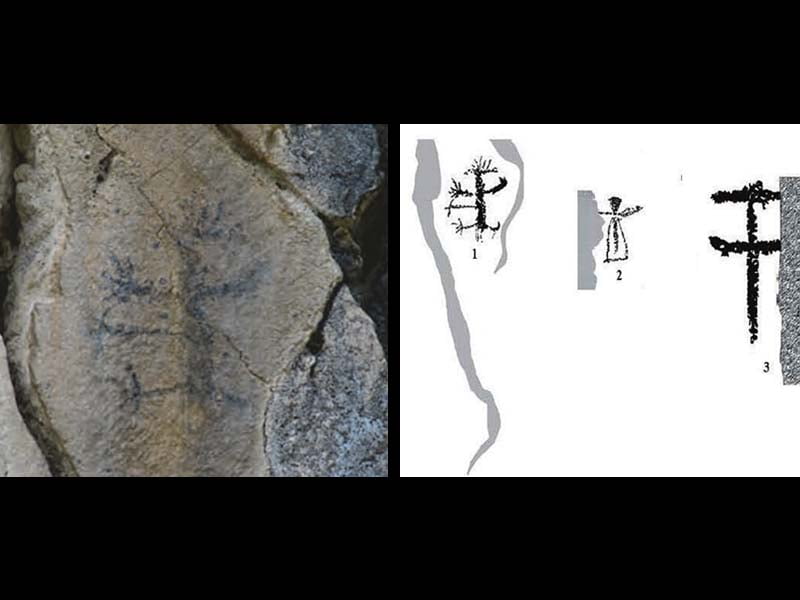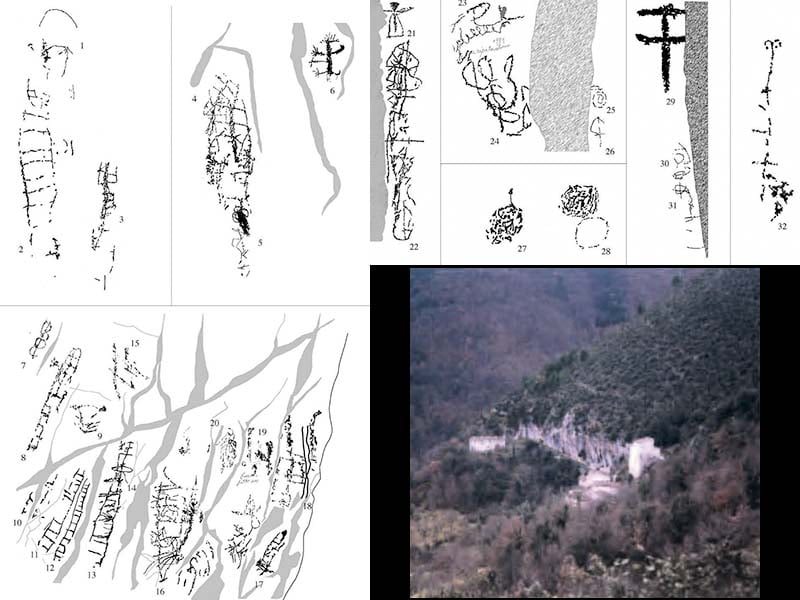In total, thirty-one black and one red paintings were identified, distributed along the entire extension of the rocky wall, alternating with areas blackened and eroded by mold and lichens caused by modest water leaks. The figures present can be classified essentially into three categories: structures with scale motifs (at the moment the only ones known so far in the rock paintings of central-southern Italy), circular/spiral symbols, tree-shaped or triangular anthropomorphic figures. All the paintings appear to be attributable to the Copper Age.
In particular we will focus on anthropomorphic figures. One of them looks like a female representation created through the union of two triangles (to represent the head and the rest of the body), of which the upper one is in full colour, and the lower one traced with a contour line and cut by a small stroke vertical (Fig.1.2); her arms are represented horizontally extended (the left arm is partially covered by a concretion). This iconography finds close comparisons with the Iberian Peninsula.
In the other (Fig.1.1), definable arboriform, oa Greek phi halved, Tommaso Mattioli highlights the right arm resting on the side, the left arm horizontal and in which the fingers are traced, the legs apart with small strokes that recall a fringed motif or an ornament of clothing, the feet also with the indication of the toes (thus we note hands and feet in claw-like hands) and the head surmounted by a crested motif perhaps a hairstyle; an object similar to an ax-hammer in a symmetrical position is also highlighted on the left.
Lastly, a T-shaped symbol (Fig.1.3), which could fall into the category of branched schematic anthropomorphic figures: in this case, there are only two shorter horizontal segments perpendicular to the vertical axis. As far as comparisons are concerned, they can be made with some specimens painted above all in red, and belonging to the repertoire of schematic rock art of the Iberian peninsula and generally dated between the Neolithic and the early Bronze Age. With regard to the execution techniques, as also in the case of the paintings of the Shelter of Pale and Shelter of Mummies, it has been highlighted that the black paintings are characterized by a discontinuous stretch, due to the irregularity of the rocky surface; while all of the red paintings are executed in a more accurate way and with a uniform color, probably through a sort of brush and the use of a fluid dye.


Historical notes
From a geographical point of view, these localities have, with the rest of the sites identified so far in central Italy, some common characteristics in which the factors of choice of the places are probably recognisable. In fact, these are always sites located in internal Apennine mountainous areas, mostly at the confluence of small valleys and important river courses (Nera River, Menotre, etc). In general, therefore, it can be noted that these representations are common to the whole territory, above all in sites located in specific geographical positions, such as transit or control points of the territories, on rocky walls or in small shelters with difficult access but located in positions that dominate heights, transit routes or mountain passes, and present the same recurring symbols, present among other things in vast areas throughout Europe. In the case of Riparo dello Schioppo, the site faces south-west, is located at an altitude of 475 m, and overlooks the stream of the Casco, on the ancient road linking Spoleto and Monteleone; it has about 150 m of development and 15 m of height, with an almost completely smooth protruding wall. In fact, in this rare case, the representations found are located along extensive vertical walls without a roof.
The locality has been inhabited since prehistoric times; until 2006, only two inhabitants lived in the village, mother and daughter, but now the small settlement is completely deserted.
CARD
LATEST PUBLISHED TEXTS
VISIT THE FACTSHEETS BY OBJECT

